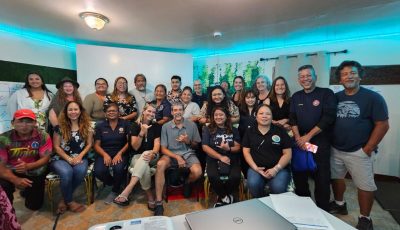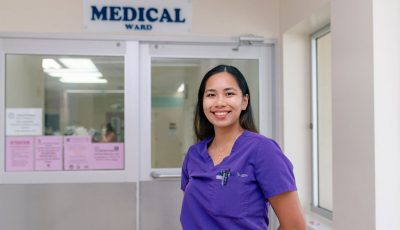SINCE JANUARY 2016 CHCC SAYS:
‘15 TB cases identified on Saipan’
Health officials going through contact tracking for possibly exposed individuals

Commonwealth Healthcare Corp. health officials held a press conference on tuberculosis to educate the public on the disease led by Division of Public Health Services medical director Dr. Ngoc-Phuong Luu, right, and state epidemiologist Dr. Paul White, center. At left is CHCC chief executive officer Esther Muna. (Frauleine Villanueva-Dizon)
A total of 15 cases of tuberculosis have been identified so far this year on Saipan, according to the Commonwealth Healthcare Corp., with the number of active ones still at three.
Of the 15 cases, three involves children aged 0 to 5 years old, while the rest are adults.
Despite the number slowly inching to 2015 statistics when 28 cases were identified in the CNMI and in 2014 when there were 32 cases, CHCC officials said there is “no cause for alarm” and that they do not label this as an “uptick” or “increase.”
“We can’t know because we need further data because sometimes it’s also seasonality, it ebbs and flows. In just measuring that, I think it will be kind of arbitrary to kind of say that by this time, its half of the year, why is it more, why is it less. As a trained epidemiologist I don’t like to put my hat on that just yet,” Division of Public Health Services medical director Dr. Ngoc-Phuong Luu said in a press conference held yesterday to “further educate the community.”
“Part of it is surveillance. As we are looking now, we are going to find more cases and as we are screening now, we’re going to find more cases,” state epidemiologist Dr. Paul White said, adding that they are more active now in screening than before.
The three cases that have been identified as active are not related and there is “no epidemiological link,” according to health officials.
Luu stressed that latent or “sleeping” TB has no symptoms and that individuals sometimes go years without even knowing that they have it.
“Even if you’re [purified protein derivative skin test] positive on the screenings for these contacts does not mean that they had the transmission at this interval. They might have been exposed when they travelled to say Vietnam five years ago but they never knew because it’s sleeping TB,” Luu said.
Contact tracking
While health officials declined to disclose other information regarding the cases such as villages or schools due to privacy reasons, CHCC said they are tracking individuals who may have been exposed. They also declined to disclose if there are recent fatalities due to TB.
“In terms of contact tracking, we are diligently doing every one of them in making sure that we made contact with which eligible person who may have been exposed,” Luu said.
“We have initiated that in the past several weeks. If they have not been contacted, it’s because they have deemed not to be a close contact of those three active TB cases,” she added.
CHCC earlier announced TB screening at Marianas High School due to possible exposure in April. Another screening was done at the school this week.
“When we talk about screening, this is entirely precautionary. It’s for those who may have been exposed,” White said.
‘Transmission is only through respiratory droplets’
Health officials stressed that one will not be infected with TB just by casual contact, or by touching or sharing of things used by an infected person, or even by kissing or sexual activity.
“It’s not transmitted through the saliva, it’s transmitted through inhaling of the coughed up bacteria deep from the lungs,” Luu said.
Transmission of TB is mainly through respiratory droplets (phlegm/sputum). People who are at highest risk of getting TB from a person with active TB are people who have a large amount of contact time with that person.
People are only able to give TB to others when they have active TB and are displaying symptoms of active TB such as prolonged coughing.
Children and pregnant women are at the same risk as anyone who has a close contact with someone who has symptoms of active TB.
Luu reiterated that there are two types of TB: active and latent (“sleeping” TB) and both are treatable.
While latent TB has no symptoms, active TB symptoms are prolonged coughing, coughing up blood, fever, chills, night sweats, and unintentional weight loss.
Treatment varies from six to nine months, depending on the type of TB.
While there is a vaccine for TB, Luu said its efficacy has been put to question.
“There is a type of vaccine called BCG and it has been used in a lot of low-income countries in the world, however, the efficacy is always put into question so the United States and CDC (Center for Disease Control and Prevention) does not have a guideline for initiation of BCG vaccination for the United States or its territories,” Luu said.
The Chest Clinic, where screenings and medications are free, has been screening 20 to 25 people a day. The Chest Clinic may be contacted at 234-8950, extension 3515 or 3514.



























